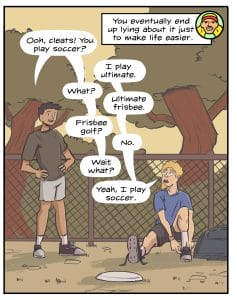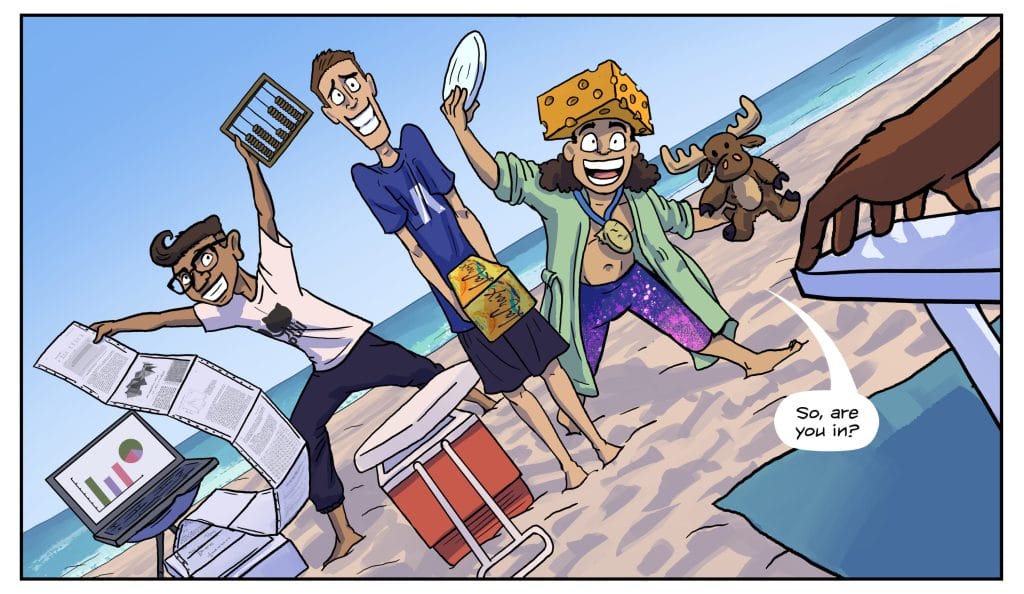Does it deserve space on the book shelf of you or the ultimate frisbee player in your life?
March 15, 2024 by Adam Ford in Opinion with 0 comments

There’s a fine line that needs to be walked whenever anyone writes a book of fiction about ultimate. How much needs to be explained? How much of the audience will be unaware of what ultimate is? Do the characters need to explicitly state what they’re doing or will the readers pick it up from context? And what about buzzwords and inside lingo? Include it? Drop it? Explain it?
“One More Year,” a richly-drawn graphic novel by Megan Praz, Meghan Kemp-Gee, Allison Hu, and Richard Mercado, treads that line for a bit near the beginning of the book, then abandons all hope of appeasing the newbies and dives horizontally into ultimate culture, trolling the depths of what it means to be an ultimate player.
 The story, simply put, is reflected in the title. Club ultimate player Clint is thinking about hanging up his cleats, wallowing in the fact that he’s never made it to Nationals, when he’s pulled out of his almost-retirement by his new friend Nadeem to sign on with a mixed beach team, gunning for a berth at Nationals. While Clint might represent ‘serious’ ultimate with his single-minded quest for tournament wins, Nadeem rolls into Clint’s life in full ‘play hard, party harder’ mode and doesn’t let up for the entirety of the story. As the book begins, the focus is on Clint, Nadeem, and Clint’s housemate Modulus (yes, many of the characters have nicknames—so ultimate), but as the plot revs up, the male-dominated narrative quickly and effectively shifts to a more equal look at those who play the sport, adding a welcome slew of women characters. One charming tool used in the storytelling is the use of two commentators who act as a Greek chorus, giving the play-by-play on the recap of Clint’s ultimate career, nudging the plot along, and adding in the necessary definitions of ultimate-culture terms. It was quite refreshing to see the two male sportscasters flip to a mixed-gender pair as the narrative shifts toward equality.
The story, simply put, is reflected in the title. Club ultimate player Clint is thinking about hanging up his cleats, wallowing in the fact that he’s never made it to Nationals, when he’s pulled out of his almost-retirement by his new friend Nadeem to sign on with a mixed beach team, gunning for a berth at Nationals. While Clint might represent ‘serious’ ultimate with his single-minded quest for tournament wins, Nadeem rolls into Clint’s life in full ‘play hard, party harder’ mode and doesn’t let up for the entirety of the story. As the book begins, the focus is on Clint, Nadeem, and Clint’s housemate Modulus (yes, many of the characters have nicknames—so ultimate), but as the plot revs up, the male-dominated narrative quickly and effectively shifts to a more equal look at those who play the sport, adding a welcome slew of women characters. One charming tool used in the storytelling is the use of two commentators who act as a Greek chorus, giving the play-by-play on the recap of Clint’s ultimate career, nudging the plot along, and adding in the necessary definitions of ultimate-culture terms. It was quite refreshing to see the two male sportscasters flip to a mixed-gender pair as the narrative shifts toward equality.
For those familiar with Megan and Meghan’s online web comic “Contested Strip,” the drawings will at once feel recognizable but the graphic novel explodes with so much more detail in the spreads and backgrounds. For those in the know, there are nods and tributes to real ultimate players scattered throughout the text and in the images. It’s a feast for the eyes and only adds to the immersion of ultimate culture.
The main characters depicted in the book—a full beach team’s worth plus a few rivals—are a trove of tropes and stereotypes, but even in those confines, they each have their own personality, brought to life with looks, words, and actions. The book is filled with the players that everyone knows—the party player, the old veteran, the calculating nerd, the determined work-ethic player, the tall one, the young phenoms…. The characterizations are not deep, and in fact, may be a little over-the-top, but they show a broad range of the people that love this sport and how they find each other as a family over the love of the game.
I’m going to interrupt this narrative with a little background on me. I love graphic novels. I have shelves full of them and the only reason I don’t have a bazillion more is that I don’t have a local comic shop to drop in on and feed my passion. True, I could browse online, but there’s something necessary about flipping through the pages of a book to see not only where the story might go, but how the illustrations affect the tone of the work. Do they convey the right feel? Do they speak volumes with minimal words? Do they carry the story regardless of the text? In the case of “One More Year,” there’s a healthy amount of dialog, minimal contrived text to manually push the narrative forward (and well done at that—never too intrusive), but the creators leave room for the images to breath once in a while, letting the artwork carry the plot. Overall, it’s busy, but not too busy.
Being an Old Guy™, the character that I probably should have most identified with was Joffrey, the crusty old player, hidden behind a mustache, set in his ways. He’s the guy who ambles about the field, potent with deadly throws and a bit slow on defense, but every once in a while pulls up a shadow of former glory with a surprising move on the field. The codger is quiet, knows his strengths, and plays for love but still has a hunger for glory. But that’s not me, really. I never had the drive to win that is the one common attribute of all the main players in this book. In fact, beyond all of the crazy scenarios and legend-making tournament situations, the thing that I found least believable in this book was the fact that a good player who works hard and seems to love the game (our hero Clint) would simply decide to give up the sport for good. I’m well into Grandmasters territory and I don’t know why I’d ever stop playing.
But then, that’s the whole hook.
The story rolls along (with, perhaps, a bit too much enthusiasm in some characters), and anyone familiar with an ultimate season (which is to say, nearly the whole target audience of this book), will feel the ups and downs along with the characters—forming the team, early season warm-up tournaments, the mid-season hiccups, overseas trips, and on to Sectionals, Regionals, and Nationals. There’s a lot of everything ultimate in this book and it shines in that regard but one downside is the relative blandness of the antagonist. Every good drama must have a foil to the heroes of the story and in this book there is, of course, a rival squad for Clint’s new team. It has players who have a particular connection to Clint, getting into his head as well as testing his physical strengths, but the rivalry doesn’t quite mature enough, leaving the ending—which (spoiler alert) sort of brings the two teams into battle with each other—satisfying, but not quite the feel-good underdog story that it might have been. To elaborate further would reveal too much plot but suffice it to say that there’s an important game against old friends and enemies, as you would expect in any good sports drama. In this case it plays out somewhat as predicted, but it still carries the story to its necessary ending.
“One More Year” is a remarkable achievement of design and storytelling, bringing ultimate into the graphic novel world. It might not be for younger kids, but if you’re a fan of ultimate and graphic novels, this would be a nice addition to your bookshelf.

—-
You can pre-order your copy of “One More Year” to get it this spring.
This is a review of the “Made in America” collector’s edition. Let’s hope that the general edition has an ISBN and will be available to the non ultimate-playing public. They may not understand it, but reading this book might give them an appreciation for what ultimate players live and breathe every year.